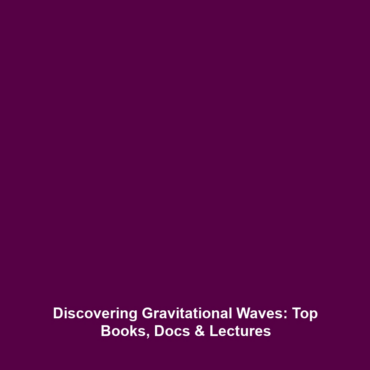Popular Science Books, Documentaries, and Lectures on Gravitational Waves
Introduction
Gravitational waves, the ripples in spacetime caused by massive celestial events, have captivated scientists and the public alike. To fully appreciate the significance of these phenomena, popular science books, documentaries, and lectures serve as vital resources. They make complex scientific concepts accessible and engage audiences, thereby fostering a greater understanding of gravitational waves. As we delve into the cosmos, these educational materials bridge the gap between advanced astrophysics and everyday curiosity, enriching our knowledge of the universe.
Key Concepts
Understanding Gravitational Waves
At the heart of gravitational wave theory lies the general theory of relativity. When massive objects like black holes or neutron stars collide, they create disturbances in spacetime that propagate outward as gravitational waves. Here are a few notable concepts that are often highlighted in accessible literature:
- Wave Propagation: Understanding how gravitational waves travel through space.
- Detection: The processes involved in detecting these waves using advanced instruments like LIGO and Virgo.
- Astronomical Events: The catastrophic events that produce measurable gravitational waves in the universe.
Applications and Real-World Uses
Popular science books, documentaries, and lectures illuminate the implications of gravitational wave research in modern science. Some applications include:
- Multi-Messenger Astronomy: Combining gravitational wave data with electromagnetic signals to provide a fuller understanding of astronomical events.
- Testing General Relativity: Analyzing gravitational waves provides unique opportunities to test Einstein’s theories in extreme conditions.
- Educational Outreach: Engaging the public and inspiring the next generation of scientists through accessible media.
Current Challenges
Despite advancements, several challenges and limitations exist in the realm of accessible science regarding gravitational waves:
- Complexity of Concepts: Some theoretical aspects of gravitational waves are inherently complex, making them difficult to convey.
- Technical Limitations: Detectors have specific thresholds and limitations which can restrict the range of detectable events.
- Public Engagement: Keeping audience interest can be tough due to the technical nature of the subject matter.
Future Research and Innovations
Looking ahead, several innovative trends and research directions promise to enhance the public’s understanding of gravitational waves:
- Enhanced Detection Technologies: The next generation of gravitational wave detectors, such as Einstein Telescope, aims to increase sensitivity and detection range.
- Interdisciplinary Studies: Increased collaboration between astrophysics and other scientific disciplines will foster new insights and educational materials.
- Digital Media Innovations: Leveraging virtual reality and interactive content to create immersive educational experiences.
Conclusion
In conclusion, popular science books, documentaries, and lectures play a crucial role in demystifying the complex topic of gravitational waves. By providing understandable explanations and compelling narratives, they not only inform but also inspire curiosity about the universe. To further explore the wonders of astrophysics, consider reading more about advanced astrophysics or watching popular documentaries on the subject. Embrace the frontier of knowledge and join the quest to understand the cosmos!
